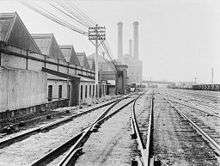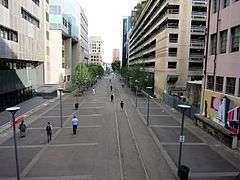The Goods Line
| The Goods Line | |
|---|---|
|
The Goods Line in November 2016 | |
| Type | urban linear park; public park |
| Location | Sydney, Australia |
| Coordinates | 40°44′54″N 74°0′18″W / 40.74833°N 74.00500°W |
| Operated by | Sydney Harbour Foreshore Authority |
| Status | Open |
The Goods Line is a linear park and pedestrian pathway approximately 500 metres long in the Sydney suburb of Ultimo. The corridor connects Railway Square to Darling Harbour and passes both University of Technology Sydney and the Australian Broadcasting Corporation.[1]
Background

The Goods Line uses the route of a former freight railway line that connected Sydney Yard and the Sydney - Parramatta railway line to the shipping port of Darling Harbour. The railway line opened in 1855 and was extended to Dulwich Hill in 1922, providing a way for freight trains to access Darling Harbour without interfering with passenger trains.[2][3][4] A short branch from Lilyfield to Rozelle served another freight terminal.
The port facilities at Darling Harbour closed down and the precinct was extensively redeveloped in the 1980s. In the following years, the Lilyfield - Sydney Yard section became disused and a light rail line opened between Pyrmont and Central Station in 1997.[5] The light rail left the former railway corridor at Hay Street, leaving a short section of the corridor disused.
Creation
A section of the corridor, between Railway Square and the Devonshire Street Tunnel and Ultimo Road was converted to a pedestrian pathway called the Ultimo Pedestrian Network. The corridor was renamed The Goods Line in 2012 and plans were announced to expand the pathway through to Hay Street.[6] This section opened on 30 August 2015.[7] The adjacent Dr Chau Chak Wing Building opened earlier in 2015; an entrance to the building is provided from The Goods Line.
Design
The Goods Line was designed by ASPECT Studios and CHROFI.[1][7] Design features include grassy lawns, dining tables, table tennis tables, study pods and a children’s water play area with a sand pit.[3] The design choices also took cues from the railways and the designers suggested that instead of transporting materials and produce, the corridor now transports commodities of the modern economy: ideas, people, social and cultural interactions.[8] Several rail artefacts have been preserved, including a bridge over Ultimo Road built in 1879 and a lever frame from the Ultimo Street Signal Box.[9][10] The design won a 2014 Australia Award for Urban Design in the Policies, Programs and Concepts – Small Scale category.[11]
Future
The original section, from Railway Square to Ultimo Road, will be upgraded.[1] Transport for NSW is conducting a feasibility study on an extension towards the disused Regent Street railway station using the rail tunnel under Railway Square.[7]
See also
References
- 1 2 3 "The Goods Line". Sydney Harbour Foreshore Authority. Retrieved 11 September 2015.
- ↑ Forsyth, J.H. (ed.) (1988-93), Stations & Tracks; Vol. 1: "Main Suburban & Branches -- Illawarra & Branches". State Rail Authority of New South Wales: Sydney, p. 97.
- 1 2 "The Goods Line". darlingharbour.com. Sydney Harbour Foreshore Authority. Retrieved 11 September 2015.
- ↑ Bozier, Rolfe. "Rozelle - Darling Harbour Goods Line". NSWrail. Retrieved 18 May 2007.
- ↑ "Sydney's new light rail system" Railway Digest September 1997 page 14
- ↑ McKenny, Leesha (14 November 2012). "New York-style elevated park plan for Ultimo". The Sydney Morning Herald. Retrieved 11 September 2015.
- 1 2 3 Robertson, James (28 August 2015). "Sydney version of New York High Line to open between Central and Darling Harbour". The Sydney Morning Herald. Retrieved 11 September 2015.
- ↑ Tan, Monica (31 August 2015). "The Goods Line: it's no High Line, but a welcome green corridor for Sydney". The Guardian Australia.
- ↑ Marks, Lucy (28 August 2015). "High-rise public walkway and recreation space to connect Railway Square to Darling Harbour". Australian Broadcasting Corporation. Retrieved 11 September 2015.
- ↑ Simpson, Margaret (3 September 2015). "The Goods Line – then and now". Inside the collection – Powerhouse Museum. Museum of Applied Arts and Sciences.
- ↑ "2014 Winners & Commendations". Planning Institute of Australia. Retrieved 14 September 2015.
